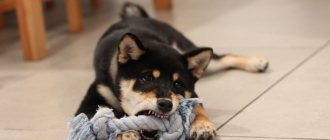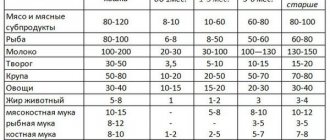How to stop your dog from chasing cats if your pet reacts too aggressively to their appearance? This question is relevant to almost all dog owners. The old proverb “they live like a cat and a dog” is just a stereotype, since the peaceful existence of these animals is not only possible, but is no longer in doubt. Many families have several pets at home, who grow up together and then become true friends.
Accustoming adult representatives of two different species to each other's company is not easy. Especially if the animals previously grew up in different places. However, with due patience it is possible.
Method one - introduction
You can stop your dog from running after cats if you introduce them to them at home. On the street, this method will not be effective.
First you need to choose an animal that can reconcile with your pet. If it is necessary to place a cat in a house where a dog has always lived, a conflict situation will arise. The dog will chase a representative of the cat tribe, protecting its territory from the encroachments of an uninvited guest. If the owner was previously a “mustachioed-striped” one, he will defend himself by attacking his opponent.
For the first acquaintance, it is better to choose an animal that previously lived in a family or shelter with other animals. In this case, it will be easier to make friends between two pets.
Efforts must be made to make the dating process peaceful. This will be stressful for your pets, so create a comfortable environment for them for the first meeting, prepare treats, and think about other reward methods. Some tips:
- Prepare the tidbits in advance. For a dog you can prepare pieces of meat products, but for a cat it is better to take chicken or tuna fillet;
- If your dog is used to your commands, refresh his memory. If not, you will have to train her to do the following:
- sit;
- approach the owner;
- stop doing something when ordered.
This training will help stop your pet during an attack or chase of a cat.
- Before meeting him, it is best to take your pet for a walk so that he has as little energy as possible to chase the mustachioed stranger.
Acquaintance should take place under the vigilant control of the owner. The dog must be held by the collar or use a short leash. If he clearly obeys the command and leaves the cat alone upon request, reward him with a “yummy” to encourage such exemplary behavior.
Consider having someone other than you present during the animal encounter. Having an assistant will greatly facilitate the dating process - it will not be difficult to keep track of both pets.
It is important to allow the cat and dog to sniff each other. There is no need to keep them at different ends of the room. When acting as a mediator, be alert and respond quickly to signs of aggression from one side or the other.
Encouragement as a way to stop a dog from chasing cats
If the animals behave well, be sure to praise them, pet them, and feed them prepared treats. The most difficult will be the first weeks, during which it is necessary to stop the animals from attacking each other. Be sure to praise them for exemplary behavior.
Lack of habit
Despite the differences in character and natural factors, there are many examples of the peaceful existence of a cat and a dog in the same house, living peacefully with each other. Another theory from scientists is that dogs are simply not used to the company of cats, but if you place a puppy and a kitten together, they will learn to live together amicably.
It will take no more than a week for pets to get comfortable and share the territory, no matter which pet moved into the house first.
Method two is to train the dog to stop unwanted actions.
If you intend to teach your dog to respond to cats, you will have to teach him to clearly respond to commands.
- Hold a piece of meat in each palm. Bring one hand to your pet's nose and let him smell. Your pet will understand well that there is a “yummy” sandwiched in the palm of your hand. The hand should be kept clamped, not allowing him to get to the treat;
- When trying to get the contents of your fist, pull the dog back and say “ugh”. She must clearly understand that you do not like her behavior. It is important to ignore her behavior and ensure that she stops all attempts to get to the tasty morsel;
- When the pet obeys the “fu” command, praise it and give it a treat from the other hand. Giving treats from a clenched fist that the dog wanted to unclench is not allowed.
- The exercise must be constantly repeated in order to bring the execution of the owner’s commands to automaticity. The dog must, on command, stop trying to get a treat from a clenched fist and sit in front of the owner.
Once the command has been sufficiently practiced, start using it in the presence of the cat. As soon as the animals are nearby, say “fu”. The dog will remember the command and associate it with a treat clenched in his fist. It is important to ensure that he leaves the cat alone at the command “fu” and does not perceive the “tabby” as prey.
What to do if there is a cat and a dog living in the house?
If two warring parties live in the same house, then the hardest thing will be for their owner. He will need to make a lot of effort to make them friends. We will give some useful recommendations that will help you achieve extremely positive results:
- The main rule is to have pets at the same time. This will help raise pets who will become inseparable for the rest of their lives. Otherwise, one of them will certainly dominate the other.
- If there is an adult cat in the house, and you also want to get a dog, then buy a small puppy and do not try to make friends with the animals yourself - they should get to know each other gradually.
- If you are a dog owner and your child asks for a kitten, don't deny him the pleasure. Just after bringing the fluffy ball into the house, put a muzzle and explain that you cannot offend the little creature. Experts recommend introducing animals in this situation not immediately.
- At the initial stage, feed the animals separately - dogs do not tolerate the presence of strangers while eating.
Method three - using a clicker
It is sometimes possible to wean a dog from approaching a cat using a clicker. You can buy it specifically for raising your pet. The device produces a clicking sound when you press a special button. The dog begins to respond to the click and associate it with the “correct” behavior. You can buy this device online or at any pet store. How to train?
- The pet must get used to the clicker. The click should be made immediately when the pet performs the command correctly. A calm attitude towards the cat should also be accompanied by a clicker signal;
- After the click, be sure to give your pet a piece of treat. The dog must understand and remember the connection between exemplary behavior and the click, and then between the clicker signal and the reward;
- During training, imitate the movements of a cat. This complicates training, but allows the pet to get used to living together with other animals;
- Place your dog in front of you, say “sit” and begin to quickly back away. Stop. If your dog stays put, click the clicker, praise him, and give him food.
It will not be possible to train your pet not to react to a new “neighbor” in one day. However, he will gradually remember what behavior deserves praise. Use the “fu” command if your pet starts chasing the cat. Praise your dog constantly if he follows commands accurately. While running after the striped one, stop her with the command “fu”. If she stops chasing, click the clicker and then treat her with a treat.
What is the danger of the situation?
When a dog attacks, the cat often runs away. Both animals in pursuit do not sense secondary dangers, so they often get hit by cars. It is important not to praise the dog for aggression towards the cat after the incident. Even slight approval and ignoring the situation instills in the animal the habit of attacking small animals.
Uncontrolled aggression on the part of a dog is fraught with serious injuries and even death for a cat. On the other hand, if a puppy attacks, then he has every chance of receiving precise blows with his claws in the eyes and nose with the ensuing consequences.
Method four - weaning off reacting to neighbor's cats
It is also possible to train a dog to stop attacking cats on the street. At first, your pet will have to be taken out for walks only on a leash. Allow him to walk freely only in places where the appearance of “striped predators” will be excluded.
- Take your pet out into the yard on a leash. If he tries to chase the cat, use the "ew" command. When your pet is on a leash, it is easier to stop him. However, it is necessary to ensure that you do not have to restrain the tearing dog, but that he stops on his own after your command.
- To prevent your dog from feeling threatened by cats, try to attract its attention to you. Behave calmly, reward your dog for paying attention only to you, without being distracted by the presence of other animals.
- Train your dog to always follow you, even when you let him off the leash. Practice the “near” command using a clicker or treat. Praise your pet for good behavior and for strictly following commands.
- If you live not in an apartment building, but in the private sector, try to enclose your yard with a fence. This will significantly reduce the risk of unwanted “tailed” guests appearing on your territory.
Teach your dog not to react to the appearance of street cats. Whenever your pet tries to show aggression, use the “fu” or “sit” command. Be sure to reward good behavior with a treat or kind words.
Causes of behavioral problems
Dogs in most cases guard the territory in which they live and the places where they go for walks. Having marked most of the square or park, the dog rightfully considers himself the owner of the property, therefore any appearance of uninvited guests is regarded as an attack on territorial integrity.
In addition, it is important to remember that dogs are predators and may regard cats as potential prey. The main reasons why a dog chases a cat are:
- desire to have fun;
- manifestation of hunting instincts.
For dogs, who live mostly in confined spaces, any appearance of running people, cats, cars or other moving objects is a kind of signal to action.
By tying a dog on a leash while a cat is walking nearby, the owner can provoke a backlash. Instead of calming down, the dog begins to get nervous and break out. At one point, the owner may not have time to hold the leash, and the dog, while chasing the cat, may get hit by a car.
Method five - make the cat unattractive to the pet
Try to create unpleasant associations in your dog with chasing a cat. Use any methods that are harmless to the animal׃
- sharp sound;
- cold water;
- dissatisfied tone;
- citrus-scented spray, etc.
Try spraying water on your pet if he chases the cat. The dog will remember the connection between chasing the “striped” and cold water. You can show with your voice that you are annoyed by your pet's bad behavior. Every time, let him know that his actions cause your dissatisfaction.
The pet must realize that when it actively reacts to the appearance of a cat on the horizon, the owner will be angry. You cannot shout at the dog, hit it or sharply pull the leash. You need to reprimand the dog in a calm tone with dissatisfied intonations. Animals perceive their owner’s moods very well.
If you cannot cope with the problem, contact a dog handler. He will help with training and give recommendations for further training of the dog.
Difficulty understanding verbal cues
The same movement in dogs and cats is understood in the opposite way.
- For dogs, wagging their tail means they are in a friendly mood. In cats, such a gesture is an indicator of anxiety and irritation. The cat begins to stretch out in an arc, preparing to attack. The dog does not understand this behavior and reaches out to sniff the cat, for which he may get hit in the face with his claws.
- Raising a dog's paw is a demonstration of a desire to play. In the cat's perception, this is a threatening gesture.
- When a cat purrs, it means satisfaction.
- With its grumbling, the dog warns of an impending attack.
Assess your dog's interest level
It is important to understand the reasons that prompt your pet to run after cats. Usually they rush off to play with the cat or their innate instinct is triggered.
In this case, it is necessary to intervene to prevent the animals from harming each other. Cats can be very aggressive when protecting their offspring.
When a dog chases a cat as if it were prey, the situation is very serious. The dog may kill him or suffer himself. During the chase, she does not notice what is happening around her. Your pet may get run over by a car or be chased by stray dogs, who will begin to act aggressively against your pet.
Observation
When taking your dog outside, constantly monitor its behavior, and always observe how it reacts to your commands. If a cat appears in your home, do not leave the animals unattended for a month. Encourage both for good behavior, and also strictly reprimand for conflicts that arise.
Nutrition
The dog should not be allowed to eat from the cat's dishes. This causes stress for the cat. He will “take revenge” on the offender, and also show aggression towards him. A very good situation is when the animals’ bowls are nearby, and they calmly react to each other’s proximity while eating.
However, this is not easy to achieve, as the dog will try to eat the cat's treat. Patience, as well as long-term training, will teach your pet not to look into “someone else’s” plate. Exercise your dog should be done regularly. It is important to let her understand how to behave in the presence of a cat. Repeat the exercises many times, encourage your pet and it will lead to results.
Currently reading:
- Review of the best dog breeds for apartments
- Games to choose for training a dog
- The American Cocker Spaniel is an adroit hunter and loyal friend.
- Recommendations for obedience of a dog if it growls
Boredom and desire to play
Once again, different language comes into play. If the puppy wants to show his affection, to play, he wags his tail, which the cat again sees as aggression.
The dog is ready for communication and pampering, she wants to play catch. But the cat doesn’t like this type of communication. She is not happy when boundaries are violated and personal contact is made. And if there were any other animal in the place of the dog, the purr would act the same way.
Let's imagine that a puppy came to meet a cat and it lowered its ears, arched its back, wagging its tail a little - all signs to attack the noisy and pestering creature. How does the dog understand this? Indeed, in his language it is precisely this behavior that is associated with the latter’s subordination. The puppy naively believes that the cat is afraid and a “joyful meeting” occurs after which the dog will remember for the rest of his life that it is better not to meet with cats and there is no need to expect anything good from it.
Foraging
Competition for food and edible waste was most often one-sided. Dogs occupied a more advantageous position when they were close to people. Cats had to rely on their natural agility to avoid various troubles.
Guardian correspondent John Bradshaw once studied the behavior of wild cats in a Turkish village. One year, cats were everywhere and obtained food by begging for it from local residents and tourists. The following year, packs of dogs were already roaming the streets, and the journalist got the impression that the cats had disappeared. He thought so until he looked at the village from above and saw that the cats had simply moved onto the flat roofs. Most likely, they went down in search of food at night when the dogs were sleeping.
Host mistakes
Cats and dogs need time to get used to each other, and forced introductions only increase the spirit of hostility. Since cats and dogs have different comfort levels, the introduction process should not be forced.
Some dog breeders and cat owners are supporters of quickly introducing animals, forgetting about the thousand-year-old enmity of these two species. Many kittens prefer elevated resting places (trees), where they can have a great rest from overly annoying dogs.











